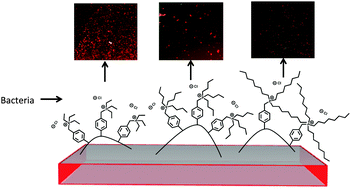Synthesis, properties, and antibacterial activity of polyphosphonium semi-interpenetrating networks†
Abstract
The development of new approaches to antibacterial surfaces is of growing interest to combat the spread of harmful bacterial infections. Relative to polyammoniums, polyphosphoniums can exhibit enhanced chemical and thermal stability, but have not yet been widely explored for the preparation of antibacterial surfaces. In this work, polyphosphoniums of varying chain lengths were synthesized by reversible addition-fragmentation chain-transfer polymerization of 4-vinylbenzyl derivatives of triethyl, tributyl, and trioctylphosphonium. These polyphosphoniums were then incorporated into semi-interpenetrating networks (SIPNs) based on tetra(ethylene glycol) diacrylate (TEGDA) via a UV light-initiated curing process. Measurements of cure percentage, gel content, water contact angle, and surface charge density suggested that all polyphosphoniums were well integrated into the network with the exception of one formulation. The results also suggested that the triethylphosphonium system tended to undergo surface reversion. Even at relatively low loadings of 0.1 to 10 wt% of polyphosphonium, the surfaces exhibited high accessible surface charge. Antibacterial testing revealed high activity against S. aureus for the triethyl and tributylphosphonium SIPNs and lower activity for the trioctyl systems. On the other hand, antibacterial activity against E. coli increased with increasing alkyl chain length. This can likely be attributed to differences in the compositions of the membranes of Gram-positive versus Gram-negative bacteria. The results also indicated that while killed bacteria tended to adsorb to the surface of the triethylphosphonium system, the more hydrophobic surfaces were more effective at preventing bacterial adsorption.


 Please wait while we load your content...
Please wait while we load your content...